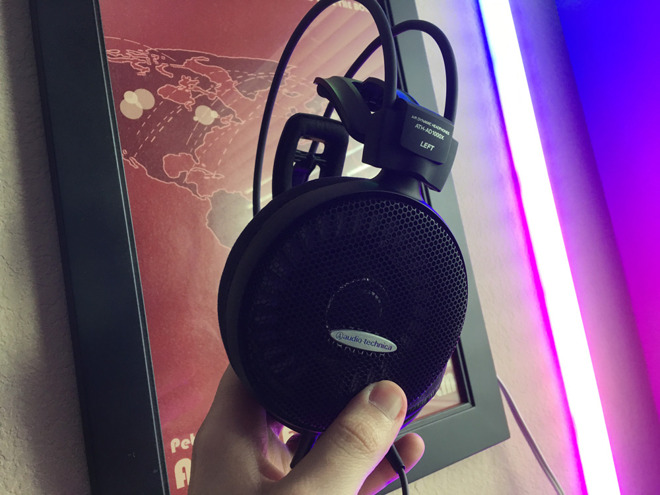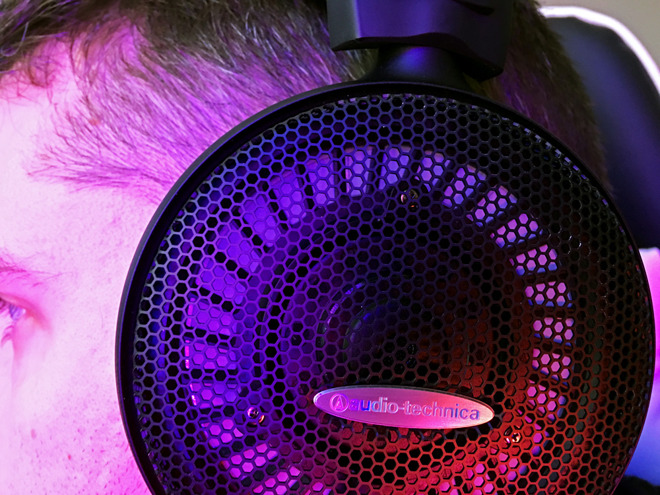Hands-on: Audio-Technica's ATH-AD1000X 'audiophile' open-back headphones
We're testing a variety of Mac- and iPhone-compatible open-back headphones, among them Audio-Technica's now more affordable ATH-AD1000X.

The AD1000X isn't new -- in fact it dates back to 2012. At the time however it cost $599.95, putting it out of range for all but the professionals and diehard audiophiles it was aimed at. The product is still on sale in 2019, but now costs just $284.82 on Amazon, which makes it a realistic option versus other high-end headphones like the Beats Studio3 Wireless.
As a quick reminder, most headphones are closed-back. That means that their drivers and so forth are shielded, which can improve qualities like noise isolation at the expense of creating a narrower soundstage. Open-back headphones tend to have a "purer" sound with a wider stage, if at the cost of bass.
The first thing I noticed wasn't the sound, but Audio-Technica's design. The headphones are incredibly light, weighing a little over 9 ounces (265 grams). This stems not just from being open-back, but having a magnesium alloy frame -- including the cup meshes -- as well as a minimalist headrest system, in which two "wings" automatically adjust to your head.
I did have to position them just right to feel secure, but after that I could almost forget I was wearing them. That's aided by the use of suede ear pads.

Audio is pumped through 53-millimeter drivers and custom voice coils. The result is incredible frequency response between 5 hertz and 40 kilohertz, easily more than a human can discern.
Everything was incredibly clear, whether video, game audio, or music ranging from ambient and classical to metal and power electronics. Bass is less punchy than some closed-back headphones, but still tangible.
The open-back design does indeed create a wider soundstage, and the headphones have excellent stereo separation to boot. I can easily recommend these to gamers, editors, and others who demand immersion.
There are only three potential problems with the AD1000X, all of which depend on the buyer. The first is audio bleed -- open-back headphones leak sound by default, so you're bound to call attention to yourself unless you're alone or in a busy environment.
By the same token they let outside noise in, such that I was able to have a conversation if music was low-key.
Lastly, the headphones' age shows in the use of a fixed 3.5-millimeter cable connection instead of Bluetooth. It's a thick, durable cable, but it measures nearly 10 feet and its metal connector won't work with some iPhone cases, so you're clearly meant to listen at home or in a studio. The package even ships with a quarter-inch adapter for musicians and other pros.
Accordingly, for Apple owners, I'd probably only suggest the AD1000X if you're pairing it with a Mac or iPad. It's certainly usable with an iPhone if you have an adapter, but practically speaking there are better choices.
Within these constraints the AD1000X gets a thumbs up -- just remember to buy through third-party retailers if you want what it's worth in 2019.

The AD1000X isn't new -- in fact it dates back to 2012. At the time however it cost $599.95, putting it out of range for all but the professionals and diehard audiophiles it was aimed at. The product is still on sale in 2019, but now costs just $284.82 on Amazon, which makes it a realistic option versus other high-end headphones like the Beats Studio3 Wireless.
As a quick reminder, most headphones are closed-back. That means that their drivers and so forth are shielded, which can improve qualities like noise isolation at the expense of creating a narrower soundstage. Open-back headphones tend to have a "purer" sound with a wider stage, if at the cost of bass.
The first thing I noticed wasn't the sound, but Audio-Technica's design. The headphones are incredibly light, weighing a little over 9 ounces (265 grams). This stems not just from being open-back, but having a magnesium alloy frame -- including the cup meshes -- as well as a minimalist headrest system, in which two "wings" automatically adjust to your head.
I did have to position them just right to feel secure, but after that I could almost forget I was wearing them. That's aided by the use of suede ear pads.

Audio is pumped through 53-millimeter drivers and custom voice coils. The result is incredible frequency response between 5 hertz and 40 kilohertz, easily more than a human can discern.
Everything was incredibly clear, whether video, game audio, or music ranging from ambient and classical to metal and power electronics. Bass is less punchy than some closed-back headphones, but still tangible.
The open-back design does indeed create a wider soundstage, and the headphones have excellent stereo separation to boot. I can easily recommend these to gamers, editors, and others who demand immersion.
There are only three potential problems with the AD1000X, all of which depend on the buyer. The first is audio bleed -- open-back headphones leak sound by default, so you're bound to call attention to yourself unless you're alone or in a busy environment.
By the same token they let outside noise in, such that I was able to have a conversation if music was low-key.
Lastly, the headphones' age shows in the use of a fixed 3.5-millimeter cable connection instead of Bluetooth. It's a thick, durable cable, but it measures nearly 10 feet and its metal connector won't work with some iPhone cases, so you're clearly meant to listen at home or in a studio. The package even ships with a quarter-inch adapter for musicians and other pros.
Accordingly, for Apple owners, I'd probably only suggest the AD1000X if you're pairing it with a Mac or iPad. It's certainly usable with an iPhone if you have an adapter, but practically speaking there are better choices.
Within these constraints the AD1000X gets a thumbs up -- just remember to buy through third-party retailers if you want what it's worth in 2019.

Comments
Contrary to the authors recommendation, I wouldn't buy these for gaming. That super long, permanently attached cable will be a drag. If you want open back for gaming ATX has the AD700X for under $100 available. Comes with detachable 3.5mm cable. Has no mic though. Best bet for open back gaming is Sennheisers Game ONE. $120. Has everything for the gamer. Open back gaming needs an isolated area or an understanding family. Sound will definitely bleed out into what ever room the gamer is sitting in to play.
I understand and they have better sound, but really, a set of Kef loudspeakers (choose your preferred audiophile set up here) would do much better. Maybe not at this price though.
Basically you want to be alone in a quiet space with open back headphones because, while they bleed some sound out, they also allow outside sound in. That openness is a blessing when it enhances the soundstage. It's a curse if you're in an evironment where outside noise is coming through. They really aren't meant for that type of environment.
All depends whom you don’t want to disturb. When you blast orchestra music at 2am on open back headphones, it may be a bad idea if someone is sleeping next to you, but it won’t wake up someone in the next room, or the floor above or below, nor will the cops show up with a noise citation.
Try doing that on a sufficiently powered audiophile stereo...
All depends whom you don’t want to disturb. When you blast orchestra music at 2am on open back headphones, it may be a bad idea if someone is sleeping next to you, but it won’t wake up someone in the next room, or the floor above or below, nor will the cops show up with a noise citation.
Try doing that on a sufficiently powered audiophile stereo...
Dumbest thing I read in a review in a while.
sort of like: They use SACD instead of MP3...
People who have no clue about audio gear should not be writing reviews: ALL BT audio uses lossy compression and is thus inherently non-audiophile.
Also, true audiophile DACs have much higher power requirements than the batteries in a set of headphones that’s still comfortable to wear, could handle.
Unless you have headphones using a proprietary streaming protocol with a build in DAC, wireless and audiophile don’t go together.
I too must comment on this peculiar and ill-informed assertion. The absence of Bluetooth is NOT a reflection of 'age' - it is a reflection of a quality product. Bluetooth is an inferior lossy compressed format that, by its very design, is incompatible with any audiophile product. Bluetooth also unnecessarily radiates the person wearing it, and that hardly seems a desirable attribute for anything that sits on or next to the human brain.
I enjoyed the rest of the review, and given the special price, and the lightness of the design, and the attractive appearance, may be interested to buy a pair.
If these cans were Bluetooth and used the AAC codec (rather than the inferior SBC), I would get no loss in quality if listening to Apple Music (AAC).
A blanket statement damning Bluetooth as bad is a shrill, ill-informed putdown.
It will not give a critical listener CD or ALAC quality. Under some circumstances the limitations of BT are completely acceptable. Under critical listening conditions those who deeply appreciate musical nuance employ, BT won't cut it.
Music via BT isn't shrill by definition. Implementations vary, so it could be but that's not a given. Labeling even excellent AAC or any codec's audio via BT as audiophile quality is ill-informed.
I heartily agree. There are some audiophiles who may certainly, eventually find some brand of wireless (RF/BT/WiFi) as satisfactory for listening cordlessly, under some circumstances. But for the best possible, most accurate listening, the standard will still be corded, not cordless for some time to come.
Nobody who loves musical imaging and nuance doesn't want the freedom of movement and freedom from cord microphonics. When cordless quality equals that of corded, there will be an exodus. Given the improvements of sound quality of cellular and cordless phones, I wouldn't expect that anytime soon.
This statement is pure FUD, and based on petty but obvious bias and complete ignorance of what audiophile level quality is.
You chose to make false statements to bolster some imagined facts– why, exactly? Was your mommy scared by a pair of Maggies? Did daddy abandon you because you didn't know the difference between THD and TMI?
There are idiots on both sides of the audio threshold– which I define as those who can hear it in the highest levels of sonic accuracy and those who can't. You happen to be on the Can't side and don't understand what that means. Therefore you make blanket ill-informed statements about all people who seek a higher level of audio reproduction.
That doesn't help your case, or anybody you're trying to convince. Can you offer any examples here that support what you said in your post in logical and factual fashion?